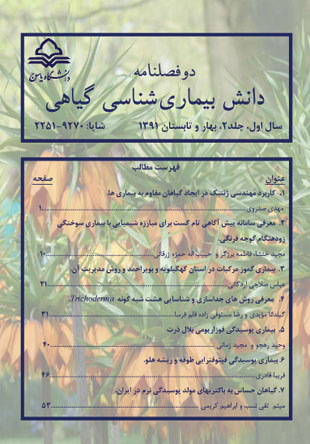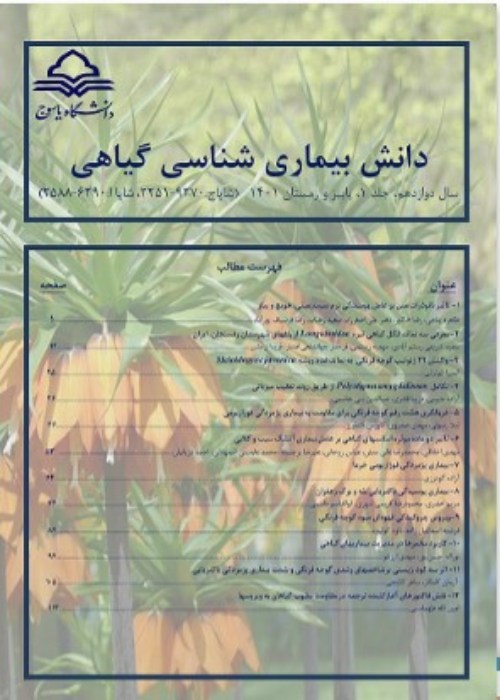فهرست مطالب

نشریه دانش بیماری شناسی گیاهی
پیاپی 2 (بهار و تابستان 1391)
- تاریخ انتشار: 1391/10/11
- تعداد عناوین: 7
-
-
صفحه 1دانش مهندسی ژنتیک از حدود 160 سال پیش با کشف قوانین وراثت صفات زیستی، آغاز گردیده و در آن روش های جداسازی و خالص سازی DNA از سلول، همانند سازی و تکثیر قطعه های آن با واکنش زنجیره ای پلیمراز، شناسایی و خالص نمودن ژن های مطلوب و انتقال آن ها به درون سلول گیاهان به طور غیر مستقیم با استفاده از باکتری Agrobacterium tumefaciens و یا به طور مستقیم با تفنگ ژنی و تولید گیاه کامل تراریخته از سلول تراریخته با کشت بافت، در طی 4 دهه اخیر ابداع و کامل گردیده اند. با استفاده از این فنآوری امکان انتقال ژن های مطلوب، بدون همراهی با هیچ ژن نامطلوبی به گیاهان میسر شده است و گیاهان تراریخته مقاوم به بیماری های قارچی، باکتریایی، ویروسی، نماتدها و تنش های محیطی تولید شده اند. مهندسی ژنتیک امیدی برای مدیریت بهتر بیماری های گیاهان و افزایش تولید محصولات کشاورزی برای تامین نیازهای غذایی جمعیت روزافزون انسان، به-وجود آورده است.
کلیدواژگان: بیماری، تراریخته، ژن، مقاوم، مهندسی -
صفحه 10سوختگی زودهنگام از بیماری های مهم گوجه فرنگی در دنیا است که کشاورزان برای مبارزه با آن مجبور به سمپاشی های مکرر می شوند. یکی از راه های کاهش مصرف سموم، هزینه های تولید و خطر آلودگی محیط زیست، سمپاشی بر اساس پیش بینی سامانه پیش آگاهی تام کست است، که در آن بر اساس مدت زمان مرطوب بودن سطح برگ ها و دما در طی دوره رشد گوجه فرنگی در هر منطقه، شدت بیماری پیش بینی و زمان مناسب سمپاشی تعیین می شود. استفاده از این سامانه در بعضی کشورها مصرف سموم روی گوجه فرنگی را به نحو قابل توجهی کاهش داده است. این سامانه زمان سمپاشی را به نحوی پیش بینی می کند که سمپاشی در زمان مورد نیاز و با تاثیر حداکثر انجام شود. با استفاده از این روش پیش آگاهی در ایران می توان ضمن کاهش مصرف سموم روی این میوه که معمولا به صورت تازه مصرف می شود، کارآیی سموم مصرفی و میزان محصول را نیز افزایش داد.
کلیدواژگان: پیش آگاهی، دما، رطوبت، سوختگی، گوجه فرنگی -
صفحه 21بیماری گموز مرکبات باعث شکاف در پوست طوقه همراه با ترشح صمغ، پوسیدگی طوقه و ریشه، خشکیدگی سرشاخه ها و زوال نهال ها و درختان می شود. این بیماری که قبلا در ایران از استان های خوزستان و فارس گزارش شده، در مناطق مله برفی، بیدستان، پشت کوه، تل مویزی، بیدزرد، چهار بیشه علیا و چهار بیشه سفلی از توابع شهرستان گچساران و چشمه بلقیس، ده برجی، اسپر و مارین از توابع شهرستان کهگیلویه در استان کهگیلویه و بویراحمد شیوع یافته است. بیشترین آلودگی به ترتیب روی لیموترش، لیموشیرین، لیمو خارکی و پرتقال دیده شده است. عامل بیماری Phytophthora nicotianae تشخیص داده شده است. این بیماری که به دلیل کاشت نهال های بیمار، شیوه نادرست کاشت نهال ها، حساسیت پایه، روش نامناسب آبیاری در این استان شیوع یافته را می توان با کاشت نهال پیوند شده روی پایه نارنج سالم و گواهی شده، اصلاح شیوه های کاشت و آبیاری، مبارزه شیمیایی و مبارزه زیستی با استفاده از قارچ ها و باکتری های متعارض مدیریت نمود.
کلیدواژگان: پوسیدگی، ریشه، سرخشکیدگی، طوقه، Phytophthora -
صفحه 31شبه گونه های Trichoderma از مهم ترین قارچ های خاک زی متعارض قارچ های بیمارگر گیاهان می باشند، که در القای مقاومت در گیاهان زراعی نیز نقش دارند، بنابراین جداسازی و شناسایی آن ها می تواند کمک زیادی به استفاده از آن ها در مبارزه زیستی با بیمارگرها نماید. این قارچ ها را می توان با روش رقیق سازی سوسپانسیون خاک و کشت روی محیط های داوه، پپتون رزبنگال و یا سیب زمینی/دکستروز/آگار تعدیل شده، جداسازی کرد. شناسایی آن ها نیز بر اساس ویژگی های پرگنه ها، خصوصیات ریخت شناسی کنیدیوم برها، فیالیدها و کنیدیوم ها صورت می-گیرد. هشتادو پنج جدایه ی Trichoderma از 25 نمونه ی خاک، 8 منطقه ی چغندرکاری استان فارس به این روش جدا و خالص سازی شدند. با مطالعه صفات آن ها، 8 شبه گونه ی Trichoderma، به اسامی T. asperellum، T.atroviride، T. brevicompactum، T. harzianum، T. longibrachiatum، T. spirale،T. tomentosum و T. virens، شناسایی شدند. روش های جداسازی، شناسایی و خصوصیات ریخت شناسی این قارچ ها شرح داده شده است.
کلیدواژگان: چغندرقند، کنیدیوم، کنیدیوم بر، فیالید، Trichoderma -
صفحه 40بیماری پوسیدگی فوزاریومی بلال یکی از مهم ترین بیماری های ذرت در ایران است. این بیماری توسط قارچ moniliforme Fusarium به وجود می آید. نشانه های آن لکه های صورتی تا قرمز رنگ روی بلال و سرانجام پوسیدگی کامل آن و افت کمی و کیفی محصول است. مناسب ترین روش مدیریت بیماری شناسایی و کشت هیبریدهای مقاوم یا نیمه مقاوم است. واکنش هیبریدها به بیماری با مایه زنی بلال با سوسپانسیون کنیدیوم های قارچ به روش سوراخ کردن در مزرعه، بر اساس شدت بیماری، تعیین می گردد. بر اساس تحقیق انجام شده در ایران از بین 12 هیبرید تحت کاشت، 2 هیبرید K3493/1 × K18 و KLM 77029/8-1-2-3-2-3 × MO17 مقاوم و 9 هیبرید نیمه مقاوم هستند. با ترویج کشت این هیبریدها، می توان به مدیریت بیماری و افزایش کمی و کیفی محصول ذرت امید داشت.
-
صفحه 46پوسیدگی طوقه و ریشه یک بیماری مهم در باغ های هلو استان کهگیلویه و بویراحمد است. نشانه های آن پژمردگی، ضعف عمومی، کم شدن شاخ و برگ ها و گاهی خشکیدگی ناگهانی درخت است. برای جداسازی بیمارگر، از محیط کشت عصاره بلغورذرت/ آگار همراه با آنتی بیوتیک های دلواسید، آمپی سیلین و ریفامپیسین استفاده می شود. عامل بیماری Phytophthora cactorum است. برای اثبات بیماری زایی آن از 2 روش مایه زنی شاخه متصل به درخت و یا آلوده کردن خاک اطراف ریشه و طوقه نهال استفاده می شود. مایه زنی ریشه و طوقه گیاهچه ها و نهال های 6 رقم هلو با این بیمارگر، نشان داده که رقم تلخه مقاوم،، ارقام آلبرتا، ردهون و هلوی قرمز مشهد نیمه حساس و ارقام انجیری و جی اچ هیل حساس به بیماری هستند.
کلیدواژگان: بیماری، پوسیدگی، طوقه، هلو، Phytophthora -
صفحه 53باکتری های مولد پوسیدگی نرم، گونه های Pectobacterium و Dickeya، از بیمارگرهای مهم گیاهان هستند، که انتشار جهانی دارند. دامنه میزبانی این باکتری ها بسیار وسیع بوده و موجب لهیدگی بافت های گیاهی می-گردند. بیماری های ناشی از این باکتری ها به شکل پوسیدگی نرم، ساقه سیاه، لهیدگی پیاز گل ها و لکه برگی در ایران از ذرت، برنج، کانولا، چغندرقند، سیب زمینی، موز، خرما، هویج، کلم، پیاز، شلغم، فلفل، فیلودندرون، پاندانوس، دیفن باخیا، سیکلامن، زنبق، آگلونما، دراسنا، گلایول، فیکوس، کاکتوس زینتی و گل جالیز گزارش شده اند. برخی از ارقام گیاهان زراعی کشور نظیر ذرت، سیب زمینی و چغندرقند نسبت به این باکتری ها متحمل شناخته شده اند.
کلیدواژگان: باکتری، پوسیدگی، نرم، Dickeya، Pectobacterium
-
Page 1Genetic engineering has begun about 160 years ago with discover inheritance laws of biological traits, isolation and purification of DNA from inner cell, replication and propagation of its pieces with polymerase chain reaction in vitro, identification and purification favorable genes and transfer them with Agrobacterium tumefaciens bacterium, or directly to plants cell, by gene gun, and produce whole transgenic plant, from gene modified cell with tissue culture methods innovation and fully developed in recent 4 decades. With this technology transfering favorable genes, without accompaniment with unwanted genes, into plants is possible, and resistance transgenic plants to fungal, bacterial, viral and nematodes, and tolerant to environmental stress produced. Genetic engineering has created hope for better plants diseases management and increase agricultural production to meet food needs of a growing human population.Keywords: Disease, Transgenic, Gene, Plant, Resistant
-
Page 10Early blight is an important worldwide disease of tomato that farmers must have frequent spray chemicals to control it. One way to reduce the use of pesticides, costs of production and the risk of environmental pollution, spraying based on forecasting of TOMCAST system, which is based on the time of wet leaves and temperature during tomato growing season in each region, predict disease severity, and determine suitable time of spraying. Application this system, in some countries considerably reduced pesticides usage on tomato. This system predict time of spraying when needed and has maximum effect. By using this forecasting method in Iran, can reduce pesticides usage on this freshly consume fruit, efficiency of using pesticides, and increase yield.Keywords: Forecasting, Temperature, Wet, Blight, Tomato
-
Page 21Citrus gummosis disease cause canker accompanied by gum exudates, crown and root rot, twig dieback, and decline of citrus trees. This disease has been reported from Khuzestan and Fars provinces, now infected by in parts of Kohgiluyeh and Boyerahmad province (southwest Iran), namely: Molabarfi, Bidestan, Posht-e-koh, Tol-e-mavizi, Bidzard, Chaharbish-e-olia and Chaharbish-e-sofla from Gachsaran town and Cheshm-e-belghis, Dehborji, Spar and Marin from Kohgiluyeh town. Sour lemon, sweet lemon, big sour lemon and orange were more infected respectively. Pathogen identified as Phytophthora nicotianae. As it is epidemic in this province for planting diseased seedlings, incorrect planting method, stalk sensitivity, incorrect irrigation method, can manage by planting healthy certified seedlings on sour orange stalk, correction planting and irrigation methods, chemical control, and biological control with antagonistic fungi or bacteria.Keywords: Rot, Root, Dieback, Crown, Phytophthora
-
Page 31Trichoderma form-species are among of the important antagonists of plant pathogenic fungi and also induce resistance in field crops. Therefore their isolation and identification could be helpful for applying them in biological control. They isolate by pour soil diluted suspension on Dawet, Peptone – Rose Bengal, or modified Potato- Dextrose-Agar mediums. Species can identify based on colony characteristics, growth characteristics and morphological characteristics of conidiophores, phialids, and conidia. Eighty-five isolates of Trichoderma from 25 soil samples, from 8 regions of the Fars province sugar beet fields, isolated and purified with this method. With studied their characteristics eight form-species of Trichoderma identified with names: T. asperellum, T. atroviride, T. brevicompactum, T. harzianum, T. longibrachiatum, T. spirale, T. tomentosum and T. virens. Methods of isolation, identification and morphological characteristics of these fungi described.Keywords: Sugar beet, Conidium, Conidiophore, Phialid, Trichoderma
-
Page 40Fusarium ear rot is one of the most important diseases of corn in Iran. This disease cause by Fusarium moniliforme fungus. Its symptoms are pink to red spots on ear, cause it completely rot and eventually loss of yield quantity and quality. Identification and cultivation resistant or semi-resistant corn hybrids is the best management method of this disease. Artificial infection of maize hybrids with fungal suspension of causal agent is an affective method to study their reactions, determine base on disease severity index (%DS). According to research conducted in Iran, between 12 planting hybrids, 2 hybrids K3493 / 1 × K18 and KLM 77029/8-1-2-3-2-3 × MO17 are resistant, and 9 are semi- resistant. With extension, cultivation of these hybrids, can manage the disease and increase the quality and quantity of maize hoped.Keywords: Rot, Maize, Resistant, Hybrid, Fusarium
-
Page 46Root and crown rot is an important disease in Kohgiluyeh and Boyerahmad province peach orchards. Its signs are wilting, general weakness, loss of foliage and sometimes sudden wilt and death of the tree. To isolate the pathogen, used corn meal-agar with antibiotics, Delvasid, Ampicillin and rifampicin medium. Pathogen is Phytophthora cactorum. For pathogenesis test, 2 inoculation methods, to a tree branch or contaminated soil around the roots and crown of seedling is used. Inoculation roots and crowns of seedlings and saplings of six varieties of peaches with this pathogen, showed that Takheh is resistant, Alberta, Redhoon and Mashhad red peach are semi-resistant, Angiri and J.H.Hill are sensitive to the disease.Keywords: Disease, Rot, Crown, Peach, Phytophthora
-
Page 53The soft rot causal bacteria, species of Pectobacterium and Dickeya, are important pathogens of plants, which have worldwide distribution. These bacteria are very broad host range and cause plant tissues rot. Diseases caused by these bacteria in the form of soft rot, black stem, bulb rot and leaf spot of corn, rice, canola, sugar beet, potatoes, banana, dates, carrots, cabbage, onions, turnips, peppers, philodendron, pandanus, dieffenbachia, Cyclamen, Iris, Aglaonema, Dracaena, Gladiolus, Ficus, ornamental cactus, and Orobanche have been reported from Iran. Some varieties of field crops such as corn, tomatoes, potatoes and sugar beet, as tolerant to these bacteria in Iran.Keywords: Bacterium, Rot, Soft, Dickeya, Pectobacterium


